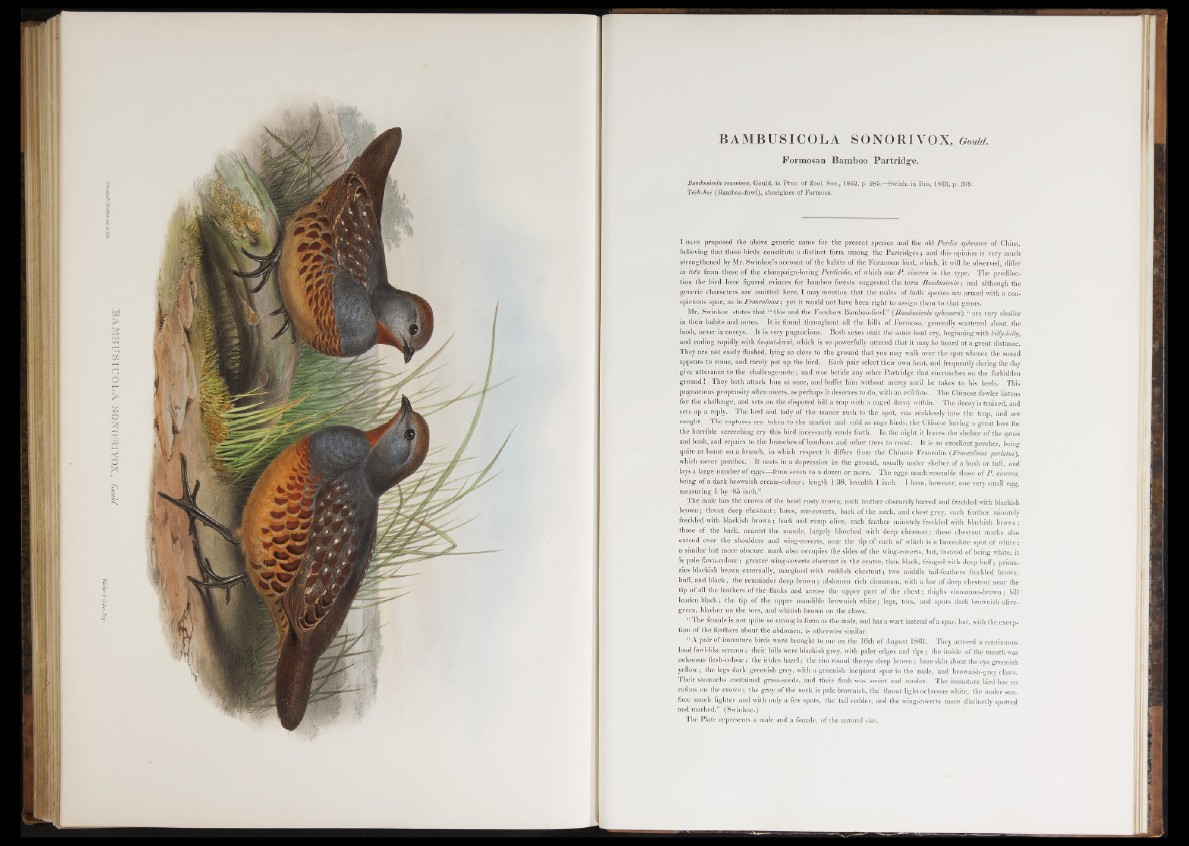
BAMBU SI CO LA SONORIYOX , Gould.
Formosan Bamboo Partridge.
Bambusicola sonorivox, Gould, in Proc. of Zool. Soc., 1862, p. 285.—Swinh. in Ibis, 1863, p. 399.
Teek-koe (Bamboo-fowl), aborigines o f Formosa.
I h a v e proposed the above generic name for the present species and the old Perdix sphenura of China,
believing that these birds constitute a distinct form among the Partridges; and this opinion is very much
strengthened by Mr. Swinhoe’s account o f the habits of the Formosan bird, which, it will be observed, differ
in toto from those of the champaign-loving Perdicidee, of which our P . cinerea is the type. The predilection
the bird here figured evinces for bamboo forests suggested the term Bambusicola; and although the
generic characters are omitted here, I may mention that the males of both species are armed with a conspicuous
spur, as in Francolinus; yet it would not have been right to assign them to that genus.
Mr. Swinhoe states that “ this and the Foochow Bamboo-fowl ” (Bambusicola sphenura) “ are very similar
in their habits and notes. It is found throughout all the hills of Formosa, generally scattered about the
bush, never in coveys. It is very pugnacious. Both sexes emit the same loud cry, beginning with kilhj-killy,
and ending rapidly with ke-put-Jcwai, which is so powerfully uttered that it may be heard at a great distance.
They are not easily flushed, lying so close to the ground that you may walk over the spot whence the sound
appears to come, and rarely put up the bird. Each pair select their own beat, and frequently during the day
give utterance to the challenge-note; and woe betide any other Partridge that encroaches on the forbidden
ground! They both attack him at once, and buffet him without mercy until he takes to his heels. This
pugnacious propensity often meets, as perhaps it deserves to do, with an evil fate. The Chinese fowler listens
for the challenge, and sets on the disputed hill a trap with a caged decoy within. The decoy is trained, and
sets up a reply. The lord and lady o f the manor rush to the spot, run recklessly into the trap, and are
caught. The captures are taken to the market and sold as cage-birds, the Chinese having a great love for
the horrible screeching cry this bird incessantly sends forth. In the night it leaves the shelter of the grass
and bush, and repairs to the branches of bamboos and other trees to roost. It is an excellent percher, being
quite at home on a branch, in which respect it differs from the Chinese Francolin (Francolinus perlatus),
which never perches. It nests in a depression in the ground, usually under shelter of a bush or tuft, and
lays a large number of eggs—from seven to a dozen or more. The eggs much resemble those o f P . cinerea,
being o f a dark brownish cream-colour; length 1-38, breadth 1 inch. I have, however, one very small egg,
measuring 1 by *85 inch.”
The male has the crown of the head rusty brown, each feather obscurely barred and freckled with blackish
brown; throat deep chestnut; lores, ear-coverts, back of the neck, and chest grey, each feather minutely
freckled with blackish brown; back and rump olive, each feather minutely freckled with blackish brown;
those of the back, nearest the mantle, largely blotched with deep chestnut; these chestnut marks also
extend over the shoulders and wing-coverts, near the tip of each of which is a lanceolate spot of white;
a similar but more obscure mark also occupies the sides o f the wing-coverts, but, instead of being white, it
is pale fawn-colour; greater wing-coverts chestnut in the centre, then black, fringed with deep buff; primaries
blackish brown externally, margined with reddish chestnut; two middle tail-feathers freckled brown,
buff, and black, the remainder deep brown; abdomen rich cinnamon, with a bar of deep chestnut near the
tip of all the feathers of the flanks and across the upper part o f the chest; thighs cinnamon-brown; bill
leaden black; the tip of the upper mandible brownish white; legs, toes, and spurs dark brownish olive-
green, blacker on the toes, and whitish brown on the claws.
“ The female is not quite so strong in form as the male, and has a wart instead of a spur, but, with the exception
of the feathers about the abdomen, is otherwise similar.
“ A pair o f immature birds were brought to me on the 16th of August 1861. They uttered a continuous
loud fowl-like scream; their bills were blackish grey, with paler edges and tips; the inside of the mouth was
ochreous flesh-colour; the irides hazel; the rim round the eye deep brown; bare skin about the eye greenish
yellow; the legs dark greenish grey, with a greenish incipient spur in the male, and brownish-grey claws.
Their stomachs contained grass-seeds, and their flesh was sweet and tender. The immature bird has no
rufous on the crown ; the grey of the neck is pale brownish, the throat light ochreous white, the under surface
much lighter and with only a few spots, the tail redder, and the wing-coverts more distinctly spotted
and marked.” (Swinhoe.)
The Plate represents a male and a female, of the natural size.